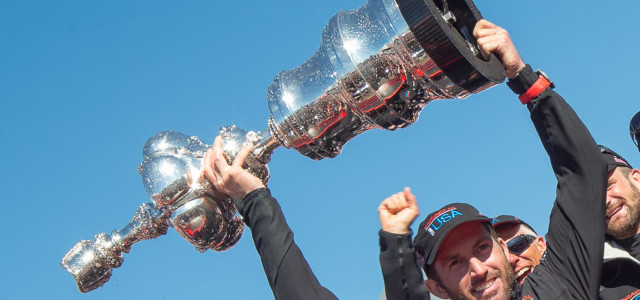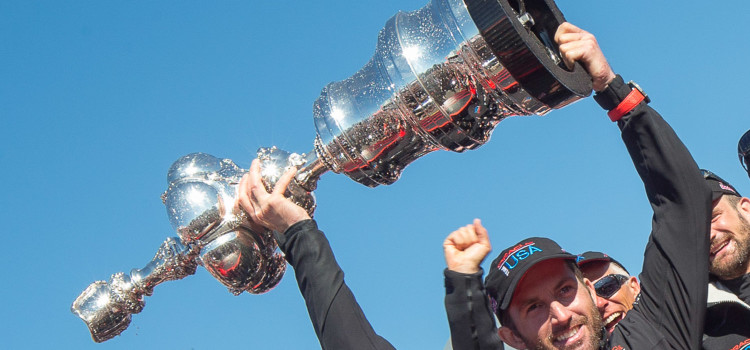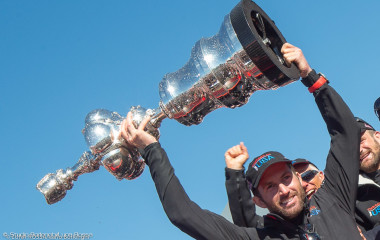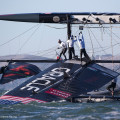


 San Francisco – I team – Ben Ainslie Racing, Team France, Oracle Team USA e Artemis Racing – hanno votato a maggioranza il cambio di classe che dovrebbe portare a una netta riduzione dei costi: si passa dai mai nati AC62 a dei catamarani ad ala rigida di lunghezza compresa tra i 45 e i 50 piedi.
San Francisco – I team – Ben Ainslie Racing, Team France, Oracle Team USA e Artemis Racing – hanno votato a maggioranza il cambio di classe che dovrebbe portare a una netta riduzione dei costi: si passa dai mai nati AC62 a dei catamarani ad ala rigida di lunghezza compresa tra i 45 e i 50 piedi.
Decisione ridicola, che sminuisce un evento da sempre unico proprio perché fuori dagli schemi e dalle regole e, in chiave futura, lo rende analogo a una qualsiasi regata di circuito, privandolo di tutto il suo fascino.
Luna Rossa aveva annunciato il suo no e, in caso di approvazione della modifica, il conseguente ritiro dalla manifestazione. Incerta la posizione di Emirates Team New Zealand, ma la mancanza di dichiarazioni nel comunicato stampa ufficiale lascia pensare a un no anche da parte kiwi.
![]()
AMERICA’S CUP, TEAM USHER IN NEW ERA
San Francisco – The America’s Cup teams have agreed to make changes aimed at significantly reducing costs for the 2017 America’s Cup.
Central to these changes is the introduction of an exciting new America’s Cup Class – a wing-sailed, foiling catamaran between 45 and 50 feet.
“The move to the new America’s Cup Class is a major step forward for the America’s Cup,” said Commercial Commissioner Harvey Schiller, following the vote.
“Collectively, the teams have agreed current costs are neither justified, nor sustainable, and a majority have together taken a sensible course of action to cut costs. I believe this puts the America’s Cup on a firm foundation for today and for the future.”
Crucially, the new class will cost much less over the life of a campaign, with potential savings across design, build and operations, making it a revolutionary cost-saving measure for the sport in both the short and long term.
“The changes being made are to reduce the current costs and complexity which are barriers to new teams wishing to enter the America’s Cup,” said Iain Percy, the team manager for Artemis Racing.
A majority of the current teams favored the new class, with the expectation it will be used in the next edition of the America’s Cup as well, in order to lower the barrier to entry – both technological and financial – to new teams.
Looking towards the future, the new America’s Cup Class will put the event on a path towards economic sustainability. Numerous one-design components will focus the design effort on areas that have an impact on performance, cutting costs significantly, but not diminishing the design challenge.
“The America’s Cup – like Formula One – has to be a design race as well as a race on the water,” noted Ben Ainslie, the team principal at Ben Ainslie Racing. “That has always been part of the Cup’s appeal. That is what attracts some of the world’s best engineers – people like Adrian Newey, who has shown a real passion for the design challenge of the America’s Cup.”
“This wasn’t an easy process,” admitted Oracle Team USA skipper Jimmy Spithill. “The established teams, ourselves included, were well down the path of designing an AC62. But there is a bigger picture to consider. We needed to bring the costs down, but we had to respect the design component of the event as that’s always been one of the biggest challenges in winning the America’s Cup.”
The savings the competitors will realize in this edition of the Cup may spark additional entries, with at least one potential team from Asia expected to challenge and other international teams considering their options.
“To be a global success, the America’s Cup needs to be accessible to the best teams, not just the biggest and wealthiest ones,” said Franck Cammas, the skipper of Team France. “So we must change in this way.”
“While it’s true there are a few critics of this move, we have to adjust to the time. This is a rule that provides the essential of the America’s Cup – the design challenge, the sport, the athletic spectacle – without such a prohibitive cost,” said Olympic medalist Roland Gaebler who has been working to establish a German Challenge. “My focus had been on the next America’s Cup but with these changes we may be able to accelerate that.”
The rule changes were passed by a majority vote of the Competitor Forum, comprising the six teams currently entered in the America’s Cup. An updated Protocol and a new Class Rule will be published this week.
A majority of the teams has also now indicated a preference that all of the racing in 2017 be conducted at a single venue, Bermuda. The America’s Cup Event Authority will consider this in nominating a venue for the America’s Cup Qualifiers.




No comments so far.
Be first to leave comment below.